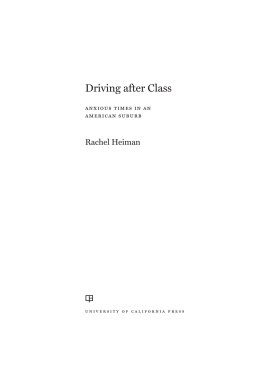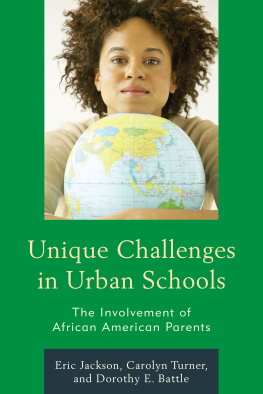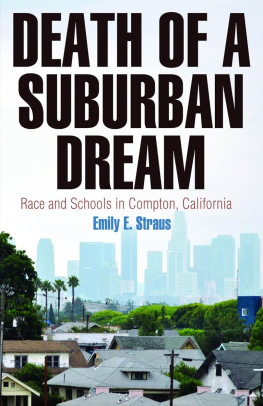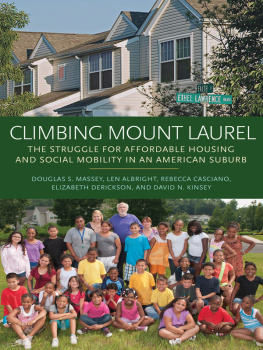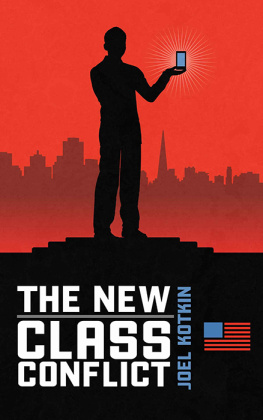CALIFORNIA SERIES IN PUBLIC ANTHROPOLOGY
The California Series in Public Anthropology emphasizes the anthropologists role as an engaged intellectual. It continues anthropologys commitment to being an ethnographic witness, to describing, in human terms, how life is lived beyond the borders of many readers experiences. But it also adds a commitment, through ethnography, to reframing the terms of public debatetransforming received, accepted understandings of social issues with new insights, new framings.
Series Editor: Robert Borofsky (Hawaii Pacific University)
Contributing Editors: Philippe Bourgois (University of Pennsylvania), Paul Farmer (Partners In Health), Alex Hinton (Rutgers University), Carolyn Nordstrom (University of Notre Dame), and Nancy Scheper-Hughes (UC Berkeley)
University of California Press Editor: Naomi Schneider
Twice Dead: Organ Transplants and the Reinvention of Death, by Margaret Lock
Birthing the Nation: Strategies of Palestinian Women in Israel, by Rhoda Ann Kanaaneh (with a foreword by Hanan Ashrawi)
Annihilating Difference: The Anthropology of Genocide , edited by Alexander Laban Hinton (with a foreword by Kenneth Roth)
Pathologies of Power: Health, Human Rights, and the New War on the Poor, by Paul Farmer (with a foreword by Amartya Sen)
Buddha Is Hiding: Refugees, Citizenship, the New America, by Aihwa Ong
Chechnya: Life in a War-Torn Society, by Valery Tishkov (with a foreword by Mikhail S. Gorbachev)
Total Confinement: Madness and Reason in the Maximum Security Prison, by Lorna A. Rhodes
Paradise in Ashes: A Guatemalan Journey of Courage, Terror, and Hope, by Beatriz Manz (with a foreword by Aryeh Neier)
Laughter Out of Place: Race, Class, Violence, and Sexuality in a Rio Shantytown, by Donna M. Goldstein
Shadows of War: Violence, Power, and International Profiteering in the Twenty-First Century, by Carolyn Nordstrom
Why Did They Kill? Cambodia in the Shadow of Genocide, by Alexander Laban Hinton (with a foreword by Robert Jay Lifton)
Yanomami: The Fierce Controversy and What We Can Learn from It , by Robert Borofsky
Why Americas Top Pundits Are Wrong: Anthropologists Talk Back , edited by Catherine Besteman and Hugh Gusterson
Prisoners of Freedom: Human Rights and the African Poor , by Harri Englund
When Bodies Remember: Experiences and Politics of AIDS in South Africa , by Didier Fassin
Global Outlaws: Crime, Money, and Power in the Contemporary World , by Carolyn Nordstrom
Archaeology as Political Action, by Randall H. McGuire
Counting the Dead: The Culture and Politics of Human Rights Activism in Colombia , by Winifred Tate
Transforming Cape Town, by Catherine Besteman
Unimagined Community: Sex, Networks, and AIDS in Uganda and South Africa, by Robert J. Thornton
Righteous Dopefiend, by Philippe Bourgois and Jeff Schonberg
Democratic Insecurities: Violence, Trauma, and Intervention in Haiti, by Erica Caple James
Partner to the Poor: A Paul Farmer Reader, by Paul Farmer, edited by Haun Saussy (with a foreword by Tracy Kidder)
I Did It to Save My Life: Love and Survival in Sierra Leone, by Catherine E. Bolten
My Name Is Jody Williams: A Vermont Girls Winding Path to the Nobel Peace Prize, by Jody Williams
Reimagining Global Health: An Introduction, by Paul Farmer, Jim Yong Kim, Arthur Kleinman, and Matthew Basilico
Fresh Fruit, Broken Bodies: Migrant Farmworkers in the United States, by Seth M. Holmes, PhD, MD
Illegality, Inc.: Clandestine Migration and the Business of Bordering Europe, by Ruben Andersson
To Repair the World: Paul Farmer Speaks to the Next Generation, by Paul Farmer
Blind Spot: How Neoliberalism Infiltrated Global Health, by Salmaan Keshavjee (with a foreword by Paul Farmer)
Driving after Class: Anxious Times in an American Suburb, by Rachel Heiman
Driving after Class
ANXIOUS TIMES IN AN AMERICAN SUBURB
Rachel Heiman

UNIVERSITY OF CALIFORNIA PRESS
University of California Press, one of the most distinguished university presses in the United States, enriches lives around the world by advancing scholarship in the humanities, social sciences, and natural sciences. Its activities are supported by the UC Press Foundation and by philanthropic contributions from individuals and institutions. For more information, visit www.ucpress.edu.
University of California Press
Oakland, California
2015 by The Regents of the University of California
Library of Congress Cataloging-in-Publication Data
Heiman, Rachel, author.
Driving after class : anxious times in an American suburb / Rachel Heiman.
pages cm
Includes bibliographical references.
ISBN 978-0-520-27774-8 (cloth : alk. paper) ISBN 978-0-520-27775-5 (pbk. : alk. paper)
eISBN 978-0-520-96031-2
1. Social classesNew Jersey. 2. Suburban lifeNew Jersey. 3. Middle classNew Jersey. 4. New JerseySocial conditions. I. Title.
HN 79. N 53S6155 2015
305.5509749dc23
2014023241
Manufactured in the United States of America
23 22 21 20 19 18 17 16 15 14
10 9 8 7 6 5 4 3 2 1
In keeping with a commitment to support environmentally responsible and sustainable printing practices, UC Press has printed this book on Natures Natural, a fiber that contains 30 percent post-consumer waste and meets the minimum requirements of ANSI/NISO Z 39.481992 ( R 1997) ( Permanence of Paper ).
Contents
Illustrations
FIGURES
MAP
TABLE
Preface
As I write this, in the winter of 2014, the United States is still reeling from the economic crash of 2008. The dramatic class inequality brought to the forewhat came to be defined through Occupy Wall Street as the problem of the 1 percentshows no signs of diminishing. Foreclosures persist at an alarming rate, as luxury-housing markets rebound. Job growth comes in spurts and starts, while CEO compensation once again skyrockets. Banks and corporations enjoy the benefits of bailouts, with students left to shoulder the crushing debt of educational loans. Nightly newscasts about further cuts in basic social services are followed by reports on stock-market highs. Despite fomenting frustration with these conditions across the political spectrum, partisan politics repeatedly brings legislative bodies of the federal government to a standstill, compounding these problems rather than solving them. Where this will lead is still an open question, and climate change and other domestic and global concerns greatly complicate these issues. But one thing is certain: the postwar version of the American dreamthe idea that suburban homeownership and its related industries would be able continually to fuel the economy, promote class mobility, and maintain a robust middle classwas dealt a severe blow.
We have spent a lot of time over the last six years looking back at what went wrong, trying to better understand how we found ourselves in a situation where the collapse of a housing bubble was able to catapult the entire economy into a downward spiral. Much of this retrospective analysis has focused, for good reason, on vulnerabilities created through too big to fail banking systems, the myriad of new forms of securitization and financialization, new types of speculation and computerization, and government regulations and safety nets that have been chipped away or have failed to keep pace with new market practices, decades of neoliberal policies, and new global players. Less time, however, has been spent grappling with the subjectivities produced during the lead up to the crash, which also are an important part of the story of how we have found ourselves in these conditions and with which we are still contending. Yearnings for upper-middle-class lifestyles continue to this day, as does the presumption that the only way to feel secure as a member of the middle class is to make it into the upper middle class. As we think deeply about how to create a new American dream that will be more sustainable and equitable than the last, it behooves us to take stock of the values, expectations, and longings that became deeply engrained in peoples habits, sentiments, and spaces during the suburban American dreams magnified last hurrah in the late 1990s. To imagine a new future, we need to appreciate not just the material structures that have led us down a problematic path but the affective structures as well.

